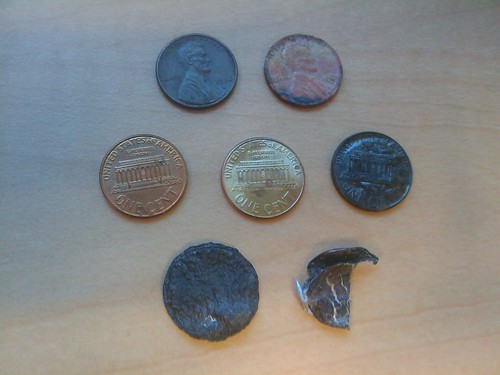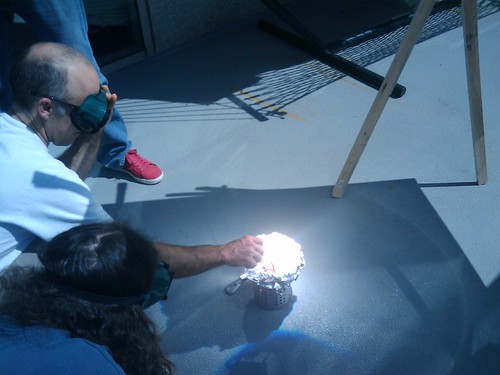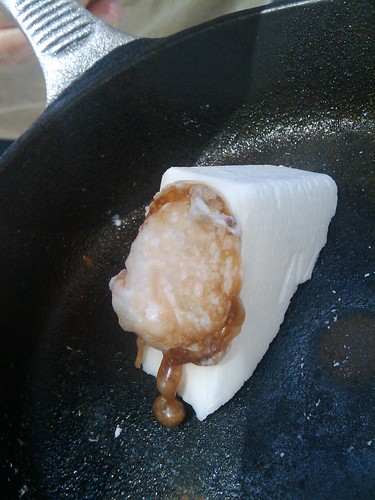Will It Lens? Table of Contents




Welcome, all! Here are links to everything in the “Will It Lens?” series.
- Part 1: introduction, melting pennies, dimes, toothpaste, Tylenol, milk, chalk, gourd, can.
- Part 2: equipment upgrades, CDs, disposable silverware, brass penny, burned pennies.
- Part 3 (Food Edition): popcorn, grape, kumquat, Frosted Mini Wheat, jelly beans, Reese’s Pieces.
- Part 4: wood, quarter, soap, dishwasher detergent, bacon, egg, honey, seashell, almonds, gummy bears, M&Ms.
- Part 5 (Temperature Breakthrough): marshmallow, peeps, copper, iron, sand, glass
- More to come
sooneventually!
- Gallery of all pictures: This contains every picture we took. There’s a lot of junk in here; the good pictures are in the blog posts above.





FREQUENTLY ASKED QUESTIONS AND SUGGESTIONS (updated)
- Can you melt glass?
This surprised us, but yes! Normal glass is more properly called “sodalime glass,” which has a much lower melting point than pure silicon dioxide (which we originally thought glass was made of, and which we haven’t been able to melt yet). However, we have trouble melting clear things because they don’t absorb the sunlight. Nonetheless, we melted a dark brown glass in part 5.
- Can you melt sand?
Kinda. The sand we tried is a mixture of quartz, feldspar, and iron. We can melt the last two, but we haven’t melted quartz yet. Look at part 5 for more details.
- Can you lens electronics?
We probably could, but we don’t want to because the fumes are really noxious. There’s lead and other stuff that’s terrible for your lungs in there.
- Can you use a second lens to focus the light even more?
No, that’s not how optics works. For a slightly more thorough answer, see the Light Sharpener FAQ over at cockeyed.com.
- Where did you get the lens? How much did it cost?
I think we got it from here. When we ordered it, I think it was about $120, plus shipping. If you include the wood for the frame and stand, the welding goggles, and the skillet, we’ve probably spent over $200 on lens-related stuff so far.
- You should lens something that will burst and explode all over the place!
That would be very entertaining, but we need to clean everything up before lunch is over, so we’re not doing anything too messy in the foreseeable future (no unopened pop cans, no aerosols, etc.). If we ever take the lens out to the middle of the desert, we will consider lensing messy things.
- You should lens an iPhone, iPod, or other hip status symbol.
First, see question 3 about electronics. Then, remember that we’re paying for all of this with our own money. We’d prefer not to lens anything that costs more than a couple dollars. Everything we’ve tried so far has cost under $1 each (almost everything is under $0.25 each).
- Isn’t it illegal to destroy money?
Not unless you do it with the intent to defraud someone. Remember the last time you went to the zoo? You probably saw one of those machines that will take your penny, flatten it out, and stamp an image of a penguin or something on it as a souvenir. Melting a penny is no more illegal than one of those machines.
Other articles that link to this series:
tip
Hello! I liked your lense-experiment! I imagine that you are physicist or something. How much did you pay for the lense? It would be cool to have one of those! Maybe something i could bye for my mom :p
I have one tip for what you can make: A potato canon. It is fun, not to expensive, easy to make and you can shoot a potato more than 200 meters if you make it correct. You just need some pipes, flammable gass and that’s pritty much it :)
contact me @ twitter for further info,name: ingvarandersen
have a nice day!
Re: tip
The lens itself was $120, but we’ve probably spent a total of $200 including all the other equipment we’ve got (the frame, the stand, the goggles, etc).
Using the lens to light a potato gun could be a very cool idea if we were out in the open, far away from anything that might be damaged by a falling potato. Unfortunately, we’re in the middle of a large city, and there’s no good place to fire it off.
Idea for lens
How about lensing a household energy-intensive appliance to see if the heat from the lens could replace heat typically generated from an electric current. I was thinking a water heater, for example? Or a heating coil.
Re: Idea for lens
Solar heating systems have been pretty well explored. They’re already on the market, and if you live in a sunny area, you can buy one for your house.
cook on stone
try heating up flat stone to cook your lunch on.
suggestions to lens
Hydrogen GAS (or other combustible gas) balloon
Roast some green coffee beans, from Dana Street Coffee
Some metal pipe or other apparatus that when heated at high temps causes an audible noise. (may be create a simple riff with a series of tubes)
Re: suggestions to lens
Interesting ideas! I’ll mention the first two to the group. I don’t think I’m familiar with heated pipes making noise; could you explain further? If you’re thinking of a tea kettle, I’m sure we could boil water with the lens.
Re: suggestions to lens
I was thinking something more like valveless pulse jet (example), but that would require a significant amount of more fuel. But a tea kettle sounds more more reasonable :)
Lens Idea with marketing twist
Burn your logo into texture, silhouette, and feature on google homepage.
Blow an egg up?
You should try like; Taking a glass jar and filling it with cold water (but leave ~1 inch), put an egg in it and attach the lid, put the jar upside down so the egg will (hopefully) float up to the top, and just try to blow it up. :D
The cold water should help little from keeping the glass to break before the egg pops.
But what do I know, I almost failed at physics. :D
Anyways, nice project indeed.
Re: Blow an egg up?
The water will act as a heat sink, so we won’t be able to heat the egg up significantly without also heating the water. However, this might be a neat way to make a hard boiled egg! We’d need a glass that doesn’t crack under boiling temperatures; Pyrex would probably work. I doubt the egg will explode with your set-up, but I’ll mention hard boiling an egg to the group.
Make some kind of Rube Goldberg Machine with it. I’m sure you could find a creative way to start the device out using a giant lense.
Haha! Excellent suggestion! I’ll see what we can do…
Developers power in pictures :)
super projector
can you make a super projector with the lens, for example play movie on the clouds? hehe
Re: super projector
Maybe, but we’d need a light source bright enough to still be visible when reflected off the clouds. We could buy a used searchlight for about $22,000, or rent one for a bit over $300 per night. Alternatively, we could use lasers to supply the light, but I can’t find good data on how powerful the laser would need to be. Regardless, though, we don’t have that kind of money.
Soda Can
Make sure you have some safety glass or goggles or something, but how about a soda can or water bottle that hasn’t been opened yet. The explosion from either one is enough to create at least a little entertainment, provided the water boils before the can leaks/the bottle explodes.
More: Thumb tacks (reshape them if you can), other denominations of coinage, specifically Nickles. Neoprene, Teflon or Nylon (bottle caps) Nylon has a little higher melting point (around 300F if my memory serves correctly). Aluminum? Galvanized Steel (might be a little higher of a temp rating than I thought, but worth a try to see if you can at least turn it pink)
Since surgical glass shouldn’t melt with this thing, try grabbing a candy thermometer and seeing what the temp of near the focal point would be.
Try making something artistic out of it, such as melting softer metals or plastic (mind the smell!) Maybe blend some bic ink pens in there for a little more colour in your “art”. I’m not sure if the CD will melt or not, but try mixing that in as well.
Re: Soda Can
Same guy here, but what about stakable desk organizers? Burn holes in all of them, make something artistic out of that as well.
~Jguy
Re: Soda Can
We already have plans to use an analog thermometer to find out what temperatures we can reach, but it’s a darn fine idea (I hadn’t thought of a candy thermometer; we were going to use an oven thermometer and count how many times the needle went around the dial). I’ll add nickels, nylon, and bottle caps to the list.
The soda can will make a big enough mess that we can’t clean it up before lunch is over, so we can’t do that. Thumb tacks are made of steel, which melts around 1500 K or thereabouts. We can’t melt copper at 1356 K, so we can’t melt steel, either. We’ve already done aluminum on several occasions, including the can in part 1 and the foil under the pennies in part 2. We’re not going to do Teflon because it’s mostly fluorine, and many fluorine compounds are really nasty (they used to be used as chemical weapons).
If you want to melt more stuff, especially the copper, get a crucible. The pliers and aluminum foil holders act as heat sinks, effectively transferring much of the heat away rapidly. This same principle is used to protect delicate electronics while soldering, so you get the idea of how fast something like this transfers heat. The crucible will act like an insulator, concentrating the energy even further. Good luck!
Ah, thanks! We had considered getting a crucible, but only because we were afraid of damaging the pliers and skillet (which we subsequently did, so there didn’t seem to be much point in getting a crucible any more). I hadn’t realized they’re insulators; I think you’re right that it would help us attain higher temperatures. We’ll take a second look at this!
Crucible
If you use a crucible, you might get long handled tongs with which to carry / move it.
specdav
Another use for your lens
Why don’t you place it in front of a small monitor to make it a big monitor, a la ‘Brazil’?
With a few refinements…
I’ve been playing with melting things with fresnels like this since I was 14 (which is uh… 18 years ago?). Beyond having had fun with melting stuff, I helped build a small business around melting glass with a large fresnel to make jewelry (http://www.sundropjewelry.com/)… I see someone else in the company already posted.
It’s a lot easier to work with the lens if you build a stand that allows it to rotate around two axes. Then you need a stand you can adjust the height of to hold a target. Also you need to make sure that the frame is stiff… if you get everything right, a lens of the size you have should give you a sharp focus about the size of a dime. The zinc pennies you were melting will melt and catch fire within about 3 seconds, and the copper ones will melt within 10 or 15 seconds.
As several comments note, heating things with light is quite different than heating with a flame… absorption of light instead of conduction from a hot gas. A very nice demo of this: Take tracing paper and draw with a fine black pen some design on it. Then move the paper quickly through the focus. You can cut cleanly along the drawn line since the pen absorbs much more light than the paper (timing takes some practice). Obviously if you tried this with a flame, the result would be totally different.
You can actually melt stuff up to about 3000 F if you put it in a pool of black glass (melting most any silicate rock will produce such a pool.) We’ve melted steel and pure quartz, which are both up around 3000 F.
My background is in geology, so I’ve also messed around some with rock. Good fun is had if you take some limestone and melt glass into it (beer bottle glass is fine). The CaCO3 limestone reacts with the SiO2 in the glass to release CO2 and form CaSiO3 (wollastonite) which forms fibrous crystals if you cool it slowly. Just letting the changing position of the focus move away from the pool of molten wollastonite provides a nice way to achieve the slow cooling.
Drop me an email if you want… I’m Hig (hig, then the 1st 3 digits of pi, @ gmail.com)
Seems Great Fun
I have been reading cool experiments of various googlers and I think it is the best one ,yet.
It seems so much fun and creativity when you engage in such activities.
Keep up the spirit guys.
Reminds me of when I froze soap bubbles at work
You went really hot, I went really cold. I dug around and got some pictures to put up: http://gcanyon.wordpress.com/2009/04/15/freezing-soap-bubbles/
From one Fresneler to Another
I’ve done quite a bit of fooling around with mine, so let me pass along a bit o’ knowledge. You can find more at http://www.brotherswhitney.com/2008/11/light-and-heat/
You CAN melt glass. No glass you ever encounter in your daily life is pure SiO2, it’s (almost) all soda-lime glass, and melts pretty easily if you have a smallish piece. It hits the glass transition temp at around 570C. Try a small piece of colored glass.
You have (essentially) no peak temperature limit- you’re just adding watts to something. The limitation is in how quickly the object can dump your heat, whether it’s through reradiation or convection (I’m making the assumption that it’s relatively well-insulated and not sitting on a heatsink, so the third mode of heat transfer is unlikely). Both of these are dependent on the surface area of the object, so you can get smaller objects hotter more easily… and they’re also more likely to be about the size of your concentrated spot.
These lenses are completely FREEEEEE (wheeeee)! Every monstrous old rear-projection TV being given away on craigslist has a Fresnel the size of its screen.
Lots more tricks to be told, we should hang out sometime. I’m just over in Pasadena.
… and come see my installation at Maker Faire this year!
That would be an easy way to start a camp fire… and then directly after a forest fire.
More cooking options
While it may take a little longer to cook, you could easily build an oven with a terra cotta pot (new of course and cheap), a terra cotta lid for the pot, a circular cooling rack(to hold the food or pan), a cheap foil pie plate to catch drippings, and some wadded up aluminum foil to plug the drip hole in the pot and lid. Then wrap the non-sun side with foil to capture refracted heat.
The Terra cotta would naturally distribute the heat more evenly than direct exposure as well.
Maybe you could put a roast or something out in the morning and have it for lunch…although you may need to adjust it every hour to keep the focal point on the pot.
Solar Cells
Why don’t you try using a small array of solar cell along with the lens.
The main issue of solar cells is that they are costly and cannot produce electricity that will justify their cost.
So i thought you should use a small array with the lens and check how much electricity you can produce. This might make them quite cost effective.
Don’t keep it at the focal point as it might burn.
Re: Solar Cells
We’ve considered solar cells, but they’re more expensive than we’d like. However, other people are already looking into this: http://www.reuk.co.uk/Concentrating-Solar-Voltaics.htm
P.S.: I should point out that if you live in a sunny area, solar cells do produce electricity that will justify their cost, but it takes a little under a decade to make them worthwhile, and people are impatient and don’t want to wait that long.
Try Rubiks’s Cube
This sounds so much fun. I guess u guys can try lensing a Rubik’s cube.
Re: Try Rubiks’s Cube
We’ve tried lensing the plastic cap on a bottle of water; it just smoked a lot and kinda melted. Do you expect a Rubik’s cube to be any different?